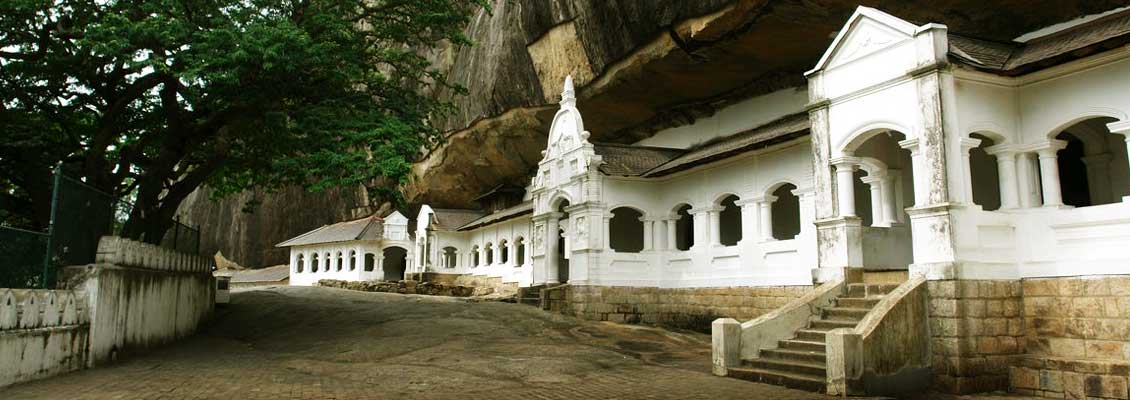DAMBULLA
South of Sigiriya on the summit of a great rock boulder is a cluster of five temples which from ancient times have been the abode of monks.
Here is a collection of rock cave temples dating back to the 1st century BC. Dambulla Rock is 152 metres in height with a colossal recumbent figure of the Buddha, 14 metres in length. The paintings on the ceilings of the caves and the many carvings depict great events in the life of the Buddha and landmarks in the history of the Sinhala people.
Dambulla, the greatest of Sri Lanka ‘s cave temples, dates from the first century BC and contains over 150 Buddha images, subtly lit for maximum atmosphere.
Actually a series of five caves, the temple is called Raja Maha Vihara by locals, but known simply as Dambulla to visitors. The entrance is marked by a large white dagoba along a long sloping rock face, from where there are views of the rock fortress of Sigiriya, about 20km away. Most of the caves were carved out by hand and some of the amazing array of Buddha statues are still attached to the wall.
The largest cave is the most spectacular. The entire roof is covered by frescoes that follow the contours of the stone to give an impression of hanging material rather than solid rock. Besides the huge reclining Buddha, the cave features a small dagoba ringed with seated meditating Buddhas and a brass pot collecting dripping water from above. No matter how severe the drought, this water continues to drip and is considered to be miraculous. Attendants carry out large baskets of heavily scented tropical flowers, left by devotees.
Driven out of the capital of Anuradhapura , King Valagam Bahu took refuge in these caves. Upon regaining the throne, he had them converted into a temple and subsequent kings added their own touches, including gilding the interior. Hindu statues date from the 12th century, when Hinduism began to make an impact on the island kingdom, before Buddhism reasserted its dominance. The frescoes are comparatively modern.
The effect of the sensitive lighting is wonderfully moody and beautiful. This can be quite a relief after the blazing neons of many Hindu temples in India. The Sri Lankans have certainly got the atmosphere right, making Dambulla a must-see on any visit to the country.
| ANURADHAPURA/ POLONNARUWA/ SIGIRIYA/ DAMBULLA
Tourist Sights/ Activity/ Excursions |
FREE Entrance |
Additional Expenses for Guest | Approximate timing | ||
| Entrance Ticket | Photo Permit | Jeep/Boat/ TukTuk/ Elephant etc. | |||
| Anuradhapura Ruins (Archeological sites) | NO | YES | NO | NO | About 05 hours |
| Sri Maha Bodiya (Tree) | NO | YES | NO | NO | About ½ hours |
| Isuruminiya Viharaya (Rock Temple) | NO | YES | NO | NO | About ½ hours |
| Mihintale Monastery & Rock | NO | YES | NO | NO | About 02 hours |
| Polonnaruwa Ruins (Archeological sites) | NO | YES | NO | NO | About 04 hours |
| Sigiriya Lion Rock Fortress | NO | YES | NO | NO | About 03 hours |
| Dambulla Buddhist Golden Temple (approx. walking 01 hour) | NO | YES | NO | NO | About 01 hour |
| Habarana Elephant Back Safari | NO | NO | NO | YES | About 01 hour |
| Minneriya National Park by Jeep | NO | YES | NO | YES | About 05 hours |
| Visit Kandalama Lake | YES | NO | NO | YES | About 1 ½ hour |
| Village tour by Bullock Cart. | YES | NO | NO | YES | About 1 ½ hour |
| Visit of a Technical tour to Herbal & Spice Garden | YES | NO | NO | NO | About 1 ½ hour |
| Pinnawela Elephant Orphanage | NO | YES | YES | NO | About 1 ½ hour |

